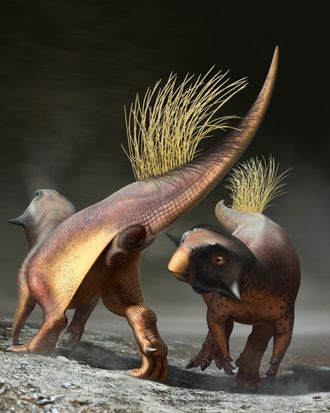
Photo: Bob Nicholls/Paleocreations.com 2020
What you are about to gaze upon is something quite extraordinary, something that has been described as “perfect” and “unique.” Direct your attention to the image accompanying this story, featuring two Psittacosaurus dinosaurs grazing a rocky terrain during the Cretaceous period — specifically, look where the left dinosaur’s back legs and tail meet. Yes, those two bulbous, oval-shaped things. Do you know what you might be looking at? That right there is our first close look at a real dinosaur butthole, never before seen (by human eyes).
How does one convey the significance of this? The English language falls short. Nevertheless, allow me to attempt. Ever since there’s been a dinosaur community, they’ve suffered from a dearth of knowledge about their muse’s hole — what it looked like, how it worked, etc. — because fossils are rarely unearthed with intact soft tissue. (Buttholes fall into this category.) So, when Jakob Vinther, a paleontologist at the University of Bristol in England, spotted an exquisitely preserved butthole on a fossilized Psittacosaurus, he was stunned.
Now, a quick aside: Technically, dinosaurs don’t have what we think of as buttholes. Instead, like birds and reptiles, they have cloacas, sort of an all-in-one hole that handles all the business affairs of the nether region: poop, pee, sperm, I’m so sorry.
Anyway, back to the notable orifice. After recognizing its pristine condition, Vinther set about creating what would become the first three-dimensional reconstruction of a dinosaur cloaca so the dinosaur community could finally get a look-see at the multipurpose hole. With the knowledge and expertise of a paleoartist and a biologist who focuses on the evolution of genitalia, they made their model, which elucidated how the orifice both looked and functioned. Their findings were published earlier this week in the scientific journal Current Biology, and now, on this very blog.
As for the what the researchers learned about the precise anatomy of the hole, I could not say. While reading the study and the ensuing coverage around it, every time I came upon “musk glands” and “lobes,” I found that I was unable to proceed because I do not like the sound of those words. I did learn, per Vice, that the preserved hole contained a piece of fossilized poop. And, of course, that the hole is just breathtaking — the “Swiss Army knife of excretory openings,” as Vinther described it in an interview with Live Science. In another interview with the New York Times, Vinther yet again reflected on the glorious hole: “Having a cloaca is not just, ‘Gee whiz, here’s a cloaca.’” Well, no, you certainly cannot argue with that.
My thoughts on the hole: It’s quite large. Like, easily the biggest butthole I’ve ever seen. Imagine if your hole had the same diameter as, what, your heel? I’ll leave you with that thought.
Let’s block ads! (Why?)
See details here >>



0 nhận xét:
Đăng nhận xét